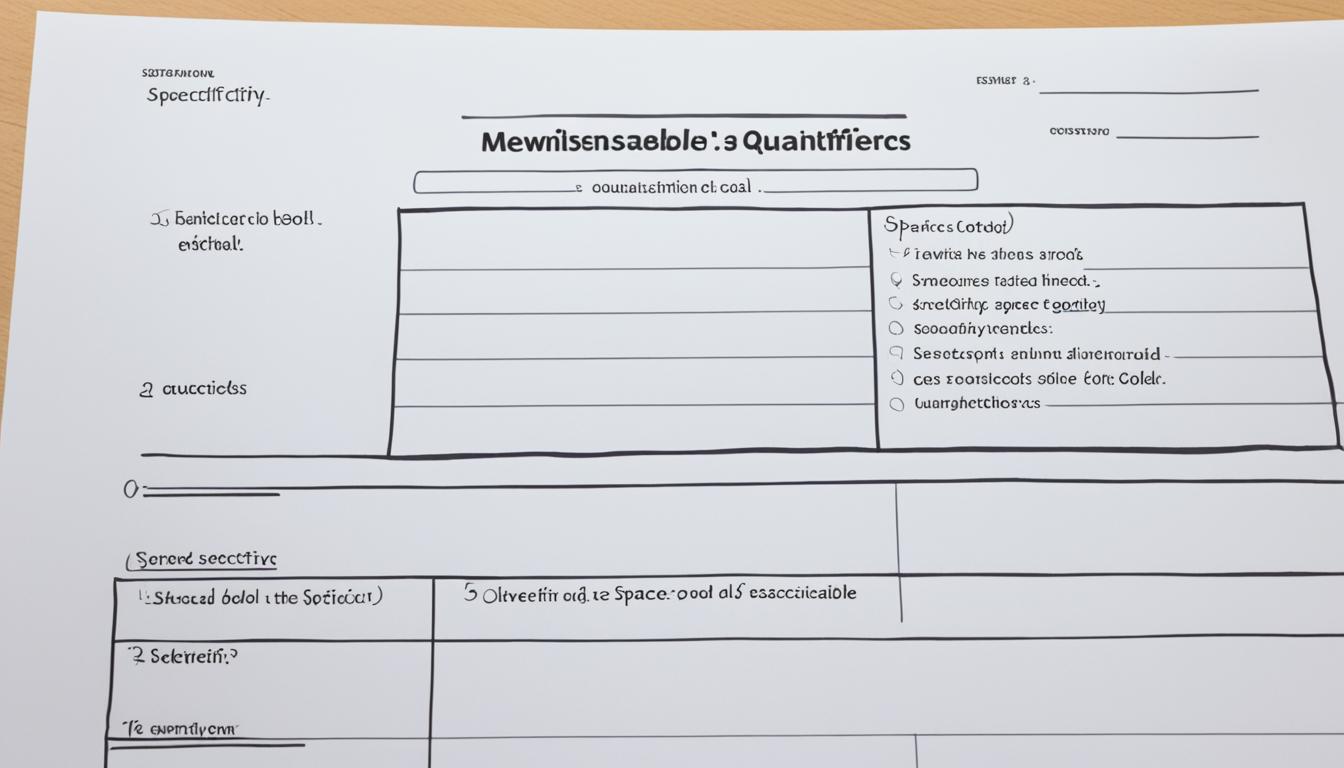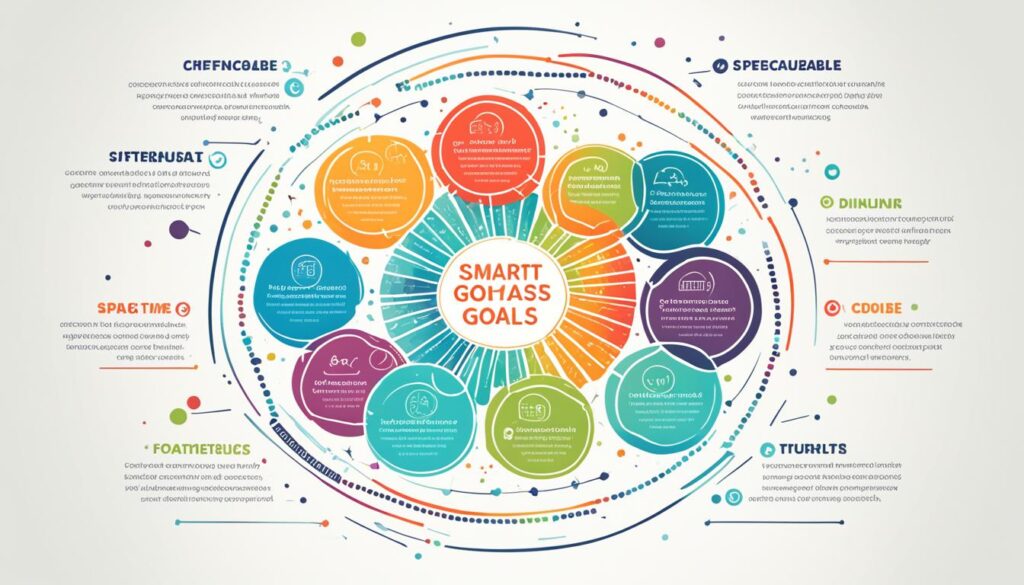Achieve Your Dreams with a SMART Goals Worksheet

Setting clear and attainable goals is essential for achieving your dreams. But how can you ensure that your goals are specific, measurable, achievable, relevant, and time-bound? Is there a practical tool that can help you streamline your path to success?
Introducing the SMART goals worksheet!
With a SMART goals worksheet, you can effectively plan and track your progress towards your goals. By utilizing a variety of templates like goal setting PDFs, smart objectives worksheets, and goal tracking sheets, you can turn your dreams into actionable steps. But how exactly does it work and why is it so effective?
Get ready to unlock the power of goal setting with a SMART goals worksheet. Discover how this tool can transform your aspirations into tangible achievements and propel you towards success.
Key Takeaways:
- Setting clear and attainable goals is crucial for achieving your dreams.
- A SMART goals worksheet helps you set Specific, Measurable, Achievable, Relevant, and Time-bound goals.
- Templates like goal setting PDFs, smart objectives worksheets, and goal tracking sheets can assist you in planning and tracking your progress.
- Using a SMART goals worksheet allows you to organize your thoughts, stay focused, and monitor your progress effectively.
- The SMART goals framework and effective goal setting strategies can turn your dreams into reality.
The Importance of Goal Setting
Goal setting plays a vital role in personal and professional development, providing direction, motivation, and a sense of purpose in life. Whether you aspire to climb the corporate ladder or improve your health and well-being, setting clear and actionable objectives is key to achieving your dreams.
By setting goals, you can:
- Clarify what you want to achieve
- Create a roadmap to success
- Stay focused on your desired outcomes
Goal setting offers numerous benefits that contribute to your overall growth and success. Some of the key advantages include:
- Increased productivity: When you set specific goals, you become more focused and driven, leading to enhanced efficiency and productivity.
- Improved self-confidence: Achieving your goals boosts your self-confidence and self-belief, empowering you to take on greater challenges.
- Enhanced time management skills: Setting deadlines and establishing priorities helps you manage your time effectively and make the most of each day.
- Greater sense of accomplishment: Accomplishing your goals provides a sense of fulfillment and satisfaction, fueling your motivation to achieve even more.
Whether you’re pursuing short-term objectives or long-term aspirations, goal setting is a powerful tool that propels you towards success. It enables you to break down complex ambitions into manageable steps, keeping you on track and accountable.

The SMART Goals Framework
The SMART goals framework is a popular and effective method for goal setting. SMART stands for Specific, Measurable, Achievable, Relevant, and Time-bound. When setting SMART goals, you define your objectives in a clear and specific manner, ensuring they are measurable and attainable within a relevant context. Additionally, you set deadlines to create a sense of urgency and hold yourself accountable. By following the SMART goals framework, you can turn your dreams into actionable steps and increase your chances of success.
How the SMART Goals Framework Works
The SMART goals framework provides a structured approach to goal setting, ensuring that your objectives are well-defined and aligned with your aspirations. Let’s break down each component of the SMART goals framework:
- Specific: Your goals should be clear and precise, leaving no room for ambiguity. Rather than setting a general goal like “lose weight,” make it specific by stating “lose 10 pounds within three months.”
- Measurable: It’s important to define metrics that can be used to track your progress. This allows you to assess your achievements and make adjustments if necessary. For example, if your goal is to increase sales, you can set measurable criteria like “increase monthly sales by 20%.”
- Achievable: While it’s essential to challenge yourself, it’s equally important to set goals that are realistic and attainable. Consider your current resources, skills, and circumstances when defining your objectives.
- Relevant: Ensure that your goals align with your overall aspirations and values. They should support your long-term vision and contribute to your personal or professional growth.
- Time-bound: Set deadlines for your goals to create a sense of urgency and establish a timeframe for completing your objectives. This helps you stay focused and motivated.
By incorporating these components into your goal setting process, you can create SMART goals that are actionable, meaningful, and conducive to success.

Example of SMART Goal Setting
Let’s explore an example of how the SMART goals framework can be applied:
| Goal | Specific | Measurable | Achievable | Relevant | Time-bound |
|---|---|---|---|---|---|
| Complete a marathon | Finish a 26.2-mile race within six months | Track progress using a running app and improve pace | Develop a training plan and gradually increase mileage | Relevant to personal fitness and well-being | Participate in a specific marathon event on a set date |
In this example, the goal to complete a marathon is made SMART by setting a specific distance and timeframe, tracking progress, ensuring it is achievable with proper training, and aligning it with personal fitness goals.
By following the SMART goals framework, you can transform your dreams into actionable steps, increase your motivation, and enhance your chances of success. Whether it’s personal or professional goals, the SMART goals framework provides a structured approach to goal setting that maximizes your potential and keeps you on track towards achieving your aspirations.
Using a SMART Goals Worksheet
Implementing the SMART goals framework can significantly enhance your goal-setting process. One valuable tool that can assist you in this journey is a SMART goals worksheet. This structured document streamlines the process of setting and tracking your goals, allowing you to stay organized and focused on achieving your dreams.
Defining Specific Objectives
A SMART goals worksheet provides a designated space to define your specific objectives. By clearly articulating what you want to achieve, you can bring your goals into sharper focus and increase your chances of success.
Establishing Measurable Criteria
Measurability is a crucial aspect of effective goal setting. With the help of a SMART goals worksheet, you can establish measurable criteria for success. This allows you to track your progress objectively and determine if you are on the right path.
Assessing Achievability and Relevance
The SMART goals worksheet prompts you to assess the achievability and relevance of your objectives. By doing so, you can ensure that your goals are realistic and aligned with your overall life aspirations. This assessment helps you set meaningful goals that are within your reach.
Setting Realistic Deadlines
Timeliness is an essential factor in goal achievement. The SMART goals worksheet enables you to set realistic deadlines for your objectives. This creates a sense of urgency and accountability, empowering you to take consistent action towards your dreams.
By utilizing a SMART goals worksheet, you can effectively organize your thoughts, stay focused, and monitor your progress. It’s a tool that acts as a compass, continually guiding you towards the realization of your aspirations.
| Benefits of Using a SMART Goals Worksheet |
|---|
| Enhanced clarity and focus in goal setting |
| Increased motivation and accountability |
| Efficient tracking of progress |
| Alignment of goals with overall life aspirations |
| Improved time management and prioritization |
The SMART goals worksheet serves as a powerful companion on your journey towards achieving your dreams. It empowers you to stay organized, motivated, and on track, aligning your efforts with the SMART goals framework.
Tips for Effective Goal Setting
To enhance the effectiveness of your goal setting, consider the following tips:
- Be specific: Clearly define your goals. Instead of saying “I want to lose weight,” specify “I want to lose 10 pounds in three months.”
- Make it measurable: Set tangible criteria for success. For example, track the number of new clients you acquire or the number of words you write each day.
- Ensure achievability: Set realistic goals that align with your capabilities and resources. It’s important to challenge yourself, but not set unattainable objectives.
- Relevance matters: Make sure your goals align with your overall vision and values. Setting goals that are meaningful to you will provide a greater sense of fulfillment and motivation.
- Set deadlines: Establish clear timelines to create a sense of urgency. Deadlines can help you stay focused, prioritize tasks, and measure progress. Remember to be realistic when setting deadlines.
By following these goal setting tips, you can increase your chances of success and effectively achieve your dreams.

| Tips | Description |
|---|---|
| Be specific | Clearly define your goals to avoid vagueness and increase focus. |
| Make it measurable | Set tangible criteria to track progress and measure success. |
| Ensure achievability | Set realistic goals that can be accomplished within your capabilities and resources. |
| Relevance matters | Create goals that align with your values and overall vision. |
| Set deadlines | Establish clear timelines to create urgency and keep yourself accountable. |
Tracking Goal Progress
Tracking your goal progress is crucial for staying motivated and on track towards achieving your dreams. By actively monitoring your progress, you can identify areas of improvement, make necessary adjustments, and celebrate your milestones along the way. To effectively track your goals, consider implementing the following strategies and utilizing goal tracking tools:
Goal Tracking Strategies
- Regularly review your goals: Set aside dedicated time to assess your progress and ensure you are on track.
- Break down your goals: Divide your goals into smaller, manageable tasks to track your progress more easily.
- Use visual cues: Create visual representations, such as progress charts or vision boards, to visually track your journey.
- Establish deadlines: Set realistic deadlines for each milestone to maintain a sense of urgency and track your progress efficiently.
- Seek accountability partners: Share your goals with a trusted friend or mentor who can help hold you accountable and provide support.
Goal Tracking Tools
There are various digital and offline tools available to help you track your goals effectively. Consider using:
- A goal tracking app: Utilize mobile applications like Trello, Todoist, or Asana to track your goals, set reminders, and monitor your progress on the go.
- A goal tracking sheet: Use a spreadsheet application, like Google Sheets or Microsoft Excel, to create a customized goal tracking sheet that suits your specific needs.
- A goal tracking journal: Keep a physical journal where you can record your goals, track your progress, and reflect on your achievements regularly.
By incorporating these goal tracking strategies and using the appropriate tools, you can maintain motivation, stay organized, and stay focused on your journey towards goal achievement.
![]()
| Goal Tracking App | Features |
|---|---|
| Trello | – Kanban-style boards for organizing goals and tasks – Collaboration features for sharing progress with others – Deadline reminders and notifications |
| Todoist | – Task management functionalities with priority levels – Reminders and due dates to ensure timely progress – Integration with other productivity tools |
| Asana | – Project management capabilities for tracking goals and subtasks – Progress tracking through visualizations and status updates – Team collaboration features for shared goals |
Overcoming Obstacles and Adjusting Goals
During your journey towards achieving your goals, it’s important to acknowledge that obstacles may arise. These obstacles can come in various forms, such as unforeseen circumstances, personal challenges, or external factors. However, overcoming these obstacles is an integral part of the goal achievement process. In order to stay on track and continue making progress, it’s crucial to remain flexible and open to adjusting your goals as needed.
One of the first steps in overcoming obstacles and adjusting goals is to identify potential challenges that may hinder your progress. By recognizing these roadblocks early on, you can develop contingency plans to address them effectively. Consider creating a list of possible obstacles and brainstorming strategies to overcome them. This proactive approach will help you navigate challenges with resilience and determination.
Furthermore, seeking support from others can be instrumental in overcoming obstacles. By reaching out to mentors, friends, or family members who can provide guidance and encouragement, you’ll strengthen your support system. Sometimes, a fresh perspective or insight from someone else can help you overcome challenges and regain momentum. Remember, you don’t have to face obstacles alone.
Adjusting your goals as necessary is another key aspect of overcoming obstacles. By evaluating your progress and reassessing your goals, you can make appropriate adjustments that reflect your current circumstances. This doesn’t mean giving up on your dreams or ambitions; rather, it’s about adapting and finding new pathways to success. Stay focused on the bigger picture and be willing to make goal adjustments that align with your evolving journey.
In summary, overcoming obstacles and adjusting goals is an essential part of the goal achievement process. By identifying potential obstacles, developing contingency plans, seeking support, and remaining flexible in your goal setting, you can navigate challenges and stay on track towards achieving your dreams.
| Common Obstacles | Strategies to Overcome |
|---|---|
| Time constraints | Prioritize tasks, delegate responsibilities, and manage time effectively |
| Lack of resources | Research alternative options, seek partnerships, or explore creative solutions |
| Self-doubt and fear | Cultivate a positive mindset, practice self-care, and seek support from others |
| External criticism or negativity | Focus on constructive feedback, surround yourself with positive influences, and stay confident in your abilities |
Conclusion
Setting SMART goals with the help of a SMART goals worksheet is a powerful tool for achieving your dreams. By following the SMART goals framework and incorporating effective goal setting strategies, you can clarify your objectives, track your progress, overcome obstacles, and ultimately turn your dreams into reality.
SMART goals, which are Specific, Measurable, Achievable, Relevant, and Time-bound, provide a clear roadmap for success. They enable you to define your goals in a specific and measurable way, ensuring they align with your overall aspirations. By setting realistic deadlines, you create a sense of urgency and hold yourself accountable for taking action.
It is crucial to regularly review and adjust your goals as needed. Life is dynamic, and circumstances may change along the journey. By staying adaptable and flexible, you can navigate obstacles and make necessary adjustments to stay on track.
With dedication, perseverance, and the use of a SMART goals worksheet, you can transform your aspirations into tangible achievements. Start today and embark on your journey towards success.






